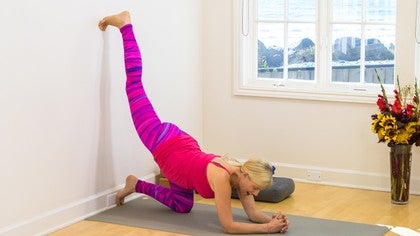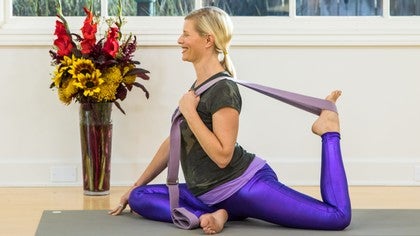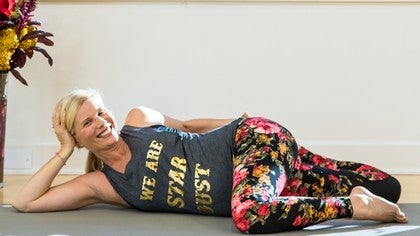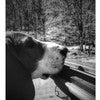Description
Transcript
Read Full Transcript
Hi, y'all. I'd love you to join me for a wall class. So we're going to start in a calf stretch. So we'll come to the wall and just bring our hands. I like mine about shoulder height. And I'm going to start with my right leg. So I'm going to bend my left leg and put it a little bit in front of me, almost like you're in a warrior one position. And then I'm going to scooch my right leg back until I can feel that I'm getting a nice stretch in my calf muscle. So, and I'm going to be here for about a minute each side. So notice when you're stretching this right lower leg, that's where we're targeting. And by the way, you might be feeling this anywhere in the back of the right leg. But notice when you're stretching this area that you can bend your knee and you still will get a nice stretch. And so in fact, some of you might actually like to bend the knee and lift the heel a little bit. So feel free to do that kind of stuff as well. Just check in with in this stretch that you're not pushing so much into the wall that you're tensing in the shoulders. So make sure that the shoulders feel relaxed. I try to think when I'm in this pose, like I imagine that I'm pushing into someone else's hands and I don't want to push them over. So I'm not shoving myself into the wall so much. But feeling a nice stretch in the lower right leg. This tends to be an area that's tense on a lot of us. So you might really be feeling this up into the back of the knee. And now I'm starting to bend a little bit more into my left leg and just get a little deeper. And then we'll just start to switch sides. So be gentle. Sometimes the ankle's a little tender after that. Don't worry about that too much unless it's really bothersome. You might give yourself more of a break, but we'll just come on to the other side. So left leg goes back and right knee is bent. And just get yourself in a position where you feel really stable. And at the same time, you're getting that stretch of the lower left leg. So I'm slightly bending my left knee and then re-straightening it. I'm tuning my bones is the way I think of it. It's like I'm using my bones almost like an antenna on an old TV set. And I'm looking for the place where the body needs my attention. So again, it's not a clear picture on the TV screen we're looking for. We're actually looking for the static. So on this side, my knee being bent.
My left leg is bent. On the right side, I had my leg straight. But on this side, it feels better to bend the knee. It feels more productive. And again, you're not pushing so much into the hands that you feel like you're going to topple over or push the wall aggressively. And then we'll just start to ease out. That's a nice position for the ankle too, just kind of waking up the bones of the ankle as long as you're not being too aggressive. And then just kind of pedal the feet out. And then we're going to take it right onto the floor. So we're going to come down into a walled dragon pose. So you'll need a few props for this pose. At least I like them. So I'm going to get a blanket and also two blocks. So I'm going to bring the blanket underneath my knee. And so I'm going to bring the blanket close to the wall because my knee is going to end up closer to the wall. I'm going to start with the right leg and I'll bring my right knee onto the blanket. And then I'll have my blocks available for me a little bit in front. So some of you could stay here. This might be a good starting point. I'm going to untuck my toes. You don't have to, but I'm going to take it and bring the left sole of my foot to the floor. So it's almost like I'm in a lunge position and now we're going to be here two minutes each side. It's almost like I'm in a lunge position, but the wall is holding up the back, the bend of the back leg, which is taking it pretty deep into the quadriceps of the front of my right thigh. You might stay here or if you want to even take it higher, you certainly could bring the hands to the thigh or shift all the way back and like arms up the wall. I'm not going there today. This is feeling like enough for me. This is a pretty intense quad stretch for most of us, especially if you're someone who's more athletic, you know, you might run or bike. But this class is good. The series that we're doing is good if you've been standing too long. So trying to really open up the legs and the hips with this class. So basically trying to help legs if they're a little tired. Starting to open up through the front of the body a little bit and take it a little bit more into a back bend. So I'm feeling it a little bit deeper into the right quadricep. Try to relax my upper body.
Keep the head and neck released. And then just start to ease your way out. I think this pose can be tough to come out of. So just be really gentle. I'm shifting my pelvis back. I'm going to slide that left leg back so that I can put my left knee on the mat safely and then I can move my right leg away. And you might just sit back for a moment and just take a little rest. And then we'll take it onto the other side as you're ready. So I'm going to bring my left knee into position first. So the left knee comes onto the blanket. The top of my left foot is against the wall. You could tuck your toes if that feels better. And this might be a good position for some of you. We're going to be here two minutes. Otherwise you can bring your right leg up and then just start to drop forward. So again, as I mentioned, you can make this a little deeper by lifting up or even by bringing your hips back. It's a little easier for me to show on this side. Bringing the hips back and lifting the arms up usually intensifies the stretch. So, but in this position today, I'm feeling it enough in my left quadricep that I don't feel like I need to go any deeper. And I'm just really letting myself sag a little bit into the pose. But certainly if you're feeling like you want to lift up more and lengthen through the front of the spine, you will feel the change in the pose. So thinking of that link through the front of the spine will really, let's say emphasize, accentuate the pose a little bit. And remember the quadriceps come up the front of the left thigh and one of them crosses over the hip joint. So you might actually start to feel it up over the hip joint a little bit too. I'm going to lean into my left arm and lift up a little bit more, getting that openness through the chest.
Probably getting a little deeper into the abdomen. You might be feeling like the psoas muscle. When I stretch my psoas muscle, it feels like I'm stretching an organ. The psoas is really deep. And then just start to ease yourself out. So shifting the pelvis back, bring the right knee down first would be my recommendation, and then move the left knee away from the wall and then just sit back. Maybe if they're, I'm going to sit back on the heels. You might take a child's pose and just take a little rest. So we'll come into giraffe next, which is a, I'm not going to need the blocks. I am not going to also use a blanket. I don't really like one in this pose, but you could certainly put one under the knee if you want to. We'll be here two minutes each side. So this is going to get a little deeper into the front of the hip. So I'm going to come down into my forearms and send my right leg up the wall. And so two minutes here. So this is a pose that's very similar to dragon. But what I like about this pose, and I really have liked, I'm pregnant and I really have enjoyed this pose being pregnant because I am able to really let the head relax and lean into the elbows more. So I get this nice back bend, but my belly's not in the way. And so you could take it up into more of like the arms of the seal pose and make it a little bit more intense. You also notice my toes are tucked. Some of you or you might bend your knee, let your knee come to the wall and bring the top of the foot to the wall. But I like the toes tucked. And you certainly could just do this as a dragon pose, but I really like the fuller version. So my head and my neck can also relax here. And you notice I'm, I'm moving. I'll tell you that I'm moving quite a bit. Not a ton, but I'm kind of tuning the pose is the way I think of it. I'm finding the spots that really need my attention. And when I find a spot where I should linger, I just linger there. This can be an intense pose. I mean, I even feel myself gripping in the fingers a little bit. So I'm constantly reminding myself to relax. And then just start to slowly ease the leg down. Be really gentle. This can be intense. I'm going to press back to a wide knee child's pose. That's what I'm craving. If you'd like something different, then do that. Then I'm just going to start to make my way back up onto all fours and transition myself onto the other side. So certainly any movement but in between sides is good. If you wanted to do cat and cow, you're welcome to do that. I'm going to send my left leg up the wall for giraffe and starting about two minutes here. So my toes are tucked. And you can work your legs straight or bent. I'm feeling such a difference in sides too, which I find very interesting and interesting in a good way. I really, I like that I'm feeling differences in sides. We are asymmetrical by nature. So if we can embrace the asymmetries of our body, perhaps we can actually start to create more balance. So this side is guiding me a little bit more towards straightening the left leg and almost veering off to the right a little bit, like a little bit of a side bend, which makes me feel like I'm getting really deep in that deep organ stretch that I talked about, which I'm assuming is the psoas. I don't know for sure. And then I can bend my knee and start to feel it more at the front of the hip. So just again, tuning the pose for yourself. You could be staying down on the forearms or you can certainly have the arms straight. I often feel a little restless in this pose, a little agitated. I don't worry about that so much. I actually don't mind if some of these poses agitate me a little bit. The whole point is to learn to breathe through the agitation to stay calm and relaxed. I'm going to start to ease this leg back down and be really gentle. And I'm going to go back into the wide knee child's pose and just rest back. So it might feel good after that back bend of giraffe to just let yourself wobble a little bit, move a little bit in a child's pose. And then I'm going to come up onto all fours, take a couple of cat-cows. That's just feeling like that's what my body needs is just a little bit of movement of the spine. Just a couple. This is just basic back bending and forward bending, but good for the spine, good for the pelvis. And then I'm going to come into a sphinx. So you can come right onto your belly for the sphinx. The way I'm doing it pregnant is this way. I'm going to come forward, rest my pelvis down on the bolster, and then I'm going to come onto my forearms. All right, so we'll be in this pose about two minutes. So the way you could do this with the wall is to come onto your belly and bend your knees and let the wall support the feet. So you are maintaining this position. This is not uncomfortable for me, but it's difficult to maneuver into being pregnant. So I'm not doing it, but it's a little easier if you don't have all this, the bolsters and the blocks and all. I also like to tuck my toes sometimes in a sphinx. That changes the pose quite a bit for me. And sometimes I actually feel a nice stretch in the arch of my feet, which is nice. I'm going to come up off my forearms and straighten my arms. So you can certainly come up a little higher if you want. So if you've been standing a lot, this is a nice pose. When we're standing, a lot of times we're in flexion, whether we know it or not. Our posture might not be that great, and we're standing with a little bit of a hunch forward. We're kind of wrapped around a phone or a TV screen or a computer screen or a steering wheel. And so if you've been standing all day long, it's nice to let the back extend. That's what we're doing right now. It doesn't matter what your range of movement is here either. If you're down on your forearms or even if you're resting your head down on your arms like a pillow, that's fine. So we're going to start to slowly come out. So just lower yourself, ease yourself down. And then you could come all the way onto your belly if you're not using a bolster like I am and just rest there, or I'm going to push back to child's pose. So I'm pressing down into the forearms and just easing myself back into a child's pose. And then we're going to come into a series of poses really using the wall now. So I'll get these out of the way. And you're going to come onto your back and come into a shoelace on your back. So I did this pose in another series seated, but we're going to do it on the back. So you might, like I might use the blanket. I'm going to put the blanket under my head. And then I'm going to cross my right leg over my left. And what's nice, so we're going to be here about two minutes. What's nice about this pose is that I can, when you're doing this seated upright, you can move the upper body, but the lower body is hard to move. And now we've reversed it. The upper body is stationary and I can move the lower body. So I can do things like this, which is really nice for me being pregnant because I can avoid the belly, any compression on the belly and get a nice stretch in the outer hip. So this might not look like shoelace per se, but what I'm feeling is a really nice stretch on the right glute, the right buttocks, but also on the outer right thigh. So I'm feeling like IT band area too. And I spoke of this earlier, but when we're standing or sitting, we are using the buttocks more than we think. We don't have to just do squats and bigger movements to use the glutes. The glutes are working all the time to stabilize the pelvis. So in positions like this where we're stretching the glutes and stretching the outer hip, let's really let the, let the glutes relax. And I might even be able to take it a little bit further, almost into like a twist if that feels okay, but I'm still trying to keep outer right hip. And although you can't see it, I feel deep within myself that as I settle into the pose, I might feel that I'm being relatively still, but the body seems to shift and move and settle into a position that's deeper. As I relax my mind, the body settles deeper. So I'm going to come back through center. Just be gentle unraveling the legs. I mentioned before that this could be, you can feel kind of fragile and vulnerable coming out of these poses. We'll just take a little rest in between sides. I just have my legs up the wall. You can rest however feels comfortable. And then we'll take it over to the other side. So I'm bending my right leg in and then I'm going to cross. So I'm not going too low down. I'm going to cross my left leg up and over my right, almost like I'm sitting in a cross-legged position. And then I'm going to just start to drop my knees over to the right. And you could certainly keep your legs straight and walk your right foot down. We're here more about two minutes, by the way, and walk your foot down. But because I'm pregnant, that's too much compression on the belly. So I'm moving my knees out of the way of the belly and still getting this really nice outer hip stretch on the left side. So it's interesting about when we come out of these poses and we feel vulnerable and fragile, that's one of the aspects of yin yoga that's interesting, that we have this short-term effect of fragility or vulnerability or rawness. But as we do these poses more often, we start to feel more sturdy in the body. So the short-term effect is very different from the long-term effect. I'm starting to walk my foot a little bit more over to the right, so I'm taking it a little bit more into a twist and maybe able to get a little deeper now into that outer left hip and down the side of the thigh into the IT band. The IT band is like the tendon for the gluteus maximus. So as you stretch the glutes, as you stretch the butt, the outer hip, you feel it often. And again, just relaxing, kind of letting the body unravel away from the legs. Just start to ease the legs back up to center, unravel the legs, and I'm running my legs up the wall for just a moment. Adjust yourself so that you feel like you're in a neutral position if that feels okay and just let everything settle. Let the bones settle. This aspect of settling the bones between poses is really nurturing. All right, so we're going to come into now a dragonfly at the wall. So my hips are a little away from the wall, so I'm going to scooch in a little bit closer. I mean, I was only a few inches, but I like to really feel that my pelvis is against the wall, so I scooched in a little bit. And then I'm just going to start to bring the legs wide. So we're going to be here about three minutes.
I hope you have a wall in your house where you can do this. A lot of people don't have an empty wall in their house where they can do this, but this is a great pose for opening up the inner thigh and the groin. Main thing I will say, and let me say, opening up the inner thigh and groin without bothering the low back. So usually the low back is pretty safe and you're able to just settle in and let gravity take over. This is a stretch though for inner thigh, adductors, and groin. So if you are feeling it in the outer hip, it might be more of like a compression. So this might not be a great pose for you. If it's painful in the outer hip and pinchy there, then you might just want to come out of it. You also might try one leg at a time. So sometimes that works if you're feeling it pinching in the outer hip. It doesn't matter how wide your legs are. I mean, this is how wide my legs go, but I've seen people who can go way further and I've seen people who are not that far apart. And none of that matters. Remember, we've got to just surrender. In a yin practice, our goal is acceptance of where we are. So we're not striving in the pose and we're not aggressive in the pose because we're not trying to perfect it. It's a real lesson in just letting things be. Not even necessarily letting go, just letting things be as they are. Letting go of something oftentimes feels as if you have to part with it, but if you can just let it be. It's just acceptance. So you might allow the legs to move a little deeper if they can. Mine are sliding a little deeper. I would not recommend doing this pose in socks unless you're pretty flexible because sometimes the socks will slide too much on the wall and it can be very uncomfortable. And also notice I'm putting my hands. You could put your hands just on your inner thigh or inner knee wherever it feels comfortable. My elbows are still resting on the floor, but it gives just a little bit of weight. Barely anything but just enough where I feel that I'm getting a little deeper. And we're just going to start to slowly bend the legs back in. So I help to facilitate the bending of my knees. I'm holding onto my outer thighs. I'm going to help my knees bend one at a time. And I'm supporting the thigh bone as I bend so that it's not like I'm using the muscle I just stretched. I'm just allowing them to bend back in. And then we're going to come into wall frog. So if you wanted a moment of legs up the wall, you could. I'm going to come right into wall frog. It feels good to me. This is like a squat at the wall. We're going to be here two minutes. This is another great pose. If squat malasana is tough for you, this is your version. You could do squat at the wall and not worry about whether the heels touch the floor. There's no pressure on my ankles, no pressure on my knees really.
So a great stretch for the inner thigh groin. I'm getting a little bit of stretch in the low back as it just curls my pelvis up a little bit. My tailbone's lifting. So I'm not pushing my tailbone down. You could. And maybe you'd feel more stretch in your inner thigh and groin. But I'm letting my tailbone lift. And your feet could be really wide or narrower. So my feet are on the wall, still is the feet on the wall. Some people actually also feel more comfortable if the soles of the feet are together and the knees are wide. Their bones just feel better in that position. So take your pick. And the feet on the wall are like a steering wheel. So you can move the feet around until you feel the pose in a different way. Anything you want to do with the arms. So a couple of breaths into the pelvis. The pelvis and the diaphragm have such an interesting relationship. So really feeling that you're releasing the pelvic floor, which is an intimate cue. And see if that helps to relax the breath. Maybe even relax the jaw. So we're going to start to slowly come out of the pose. Bring the legs up. I'm going to take the little legs up the wall to let my legs straighten out again. And we're going to come back into a glute stretch that will be a little different for some of you. So I'm going to scooch my hips back again just a bit. If you need to go back further, of course you can. Then I'm going to bend my, let's do the left leg first just to be a little different. I'm going to bend my right leg, bring the right sole of my foot to the mat, or to the wall, sorry. And then bend my left leg and bring my left ankle in front of my right knee. So this is like a swan or a pigeon at the wall. So we'll be here a minute each side, not holding it too long. You certainly could hold more if you wanted, if it feels good. So predominantly the closer your pelvis is to the wall, the more stimulation you're going to get. And then also this foot that's on the wall is a steering wheel. So if I slide my foot down, I usually feel more stimulation. And you might notice that. If you slide your foot up, you might feel less. So you're looking for that place where the pose feels a little more, like just right. It's not too hot, not too cold. It's totally like the three bears. You want the porridge just right. Feeling this outer hip, outer left hip. So glutes, maybe IT band, maybe even into the back of the thigh. And then we'll just gently switch. So bringing the legs up the wall for a moment, let the blood flow back into that left leg. So taking it onto the other side, let's bend your left leg and bring the right ankle in front of the left knee. And so I'm a little tighter on this side. I can definitely feel it. So I'm going to actually walk my left foot up the wall a little bit. And just so that I can ease out of the pose. Like there's no need to go to 100% right away. Why don't I just take it to like 65, 70% of my, of my, like don't go all the way to the edge. And the reason I say that, we're here about a minute by the way, the reason I say that is so that you can relax. If you go right to your edge, then sometimes you're almost shaky and nervous. You can't really breathe. So you back off and find that place where the body can just settle in. And then if you feel like everything's settled and you're okay, you could slide your foot down the wall. I'm not going to. I feel like this is enough for me. We're going to ease out and then we'll just finish with legs up the wall for about two minutes. So I'm going to shimmy my hips back in a little bit. You don't have to, if you weren't too far away. And I'm just going to let my legs be up the wall. I'm going to bring my arms overhead and just rest here for about two minutes. This is a great pose to do if you've been standing too long. Just letting all the stale blood from the feet ease its way back down the legs and travel with ease back to the heart. So the, we want all that blood to just be able to come back to the heart with gravity. This can be a very calming pose. And another cue that I really love that one of my teachers back home has said to me before is see if you can feel your femur bones, your thigh bones just drop down into the pelvis. I'm sure this is a new cue for some of you, but it just, it really feeling that just noticing if one femur is dropping heavier or the other one's a little tense. If you're gripping in the hip, relaxing the eyes and the jaw. Don't feel like you have to put yourself in any particular position. So let the legs just release. Even if the toes roll out, you don't need to flex the feet. I'm going to start to come out of the pose. This might again, if you're feeling really good here, this might be a great pose to just stay in a little bit longer. Maybe do set a timer though so you don't fall asleep. I've fallen asleep in that pose. And then I'm just going to roll to my left side. So my knees are bent in. I'm going to roll to my left side and start to just make my way up to a seated position. And I'm going to finish with my back against the wall, just feeling the support of the wall. I'm going to get my blanket out of the way. You could put a blanket under your hips or a bolster or something under your pelvis, but I'm just going to sit up with my back against the wall for a moment. Try to let my pelvis settle heavy and just release for a couple of breaths.
So yogis, I hope that felt good for you. I'm so glad you were with me. Namaste.
Yin Yoga: Kate Smith
Comments
You need to be a subscriber to post a comment.
Please Log In or Create an Account to start your free trial.
























